

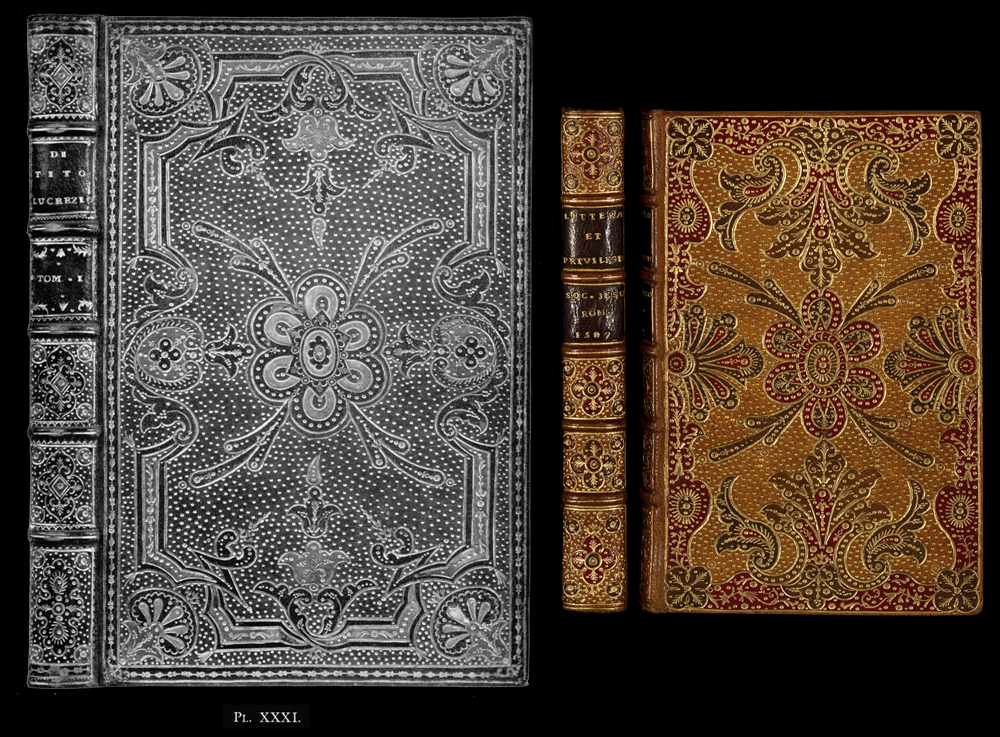
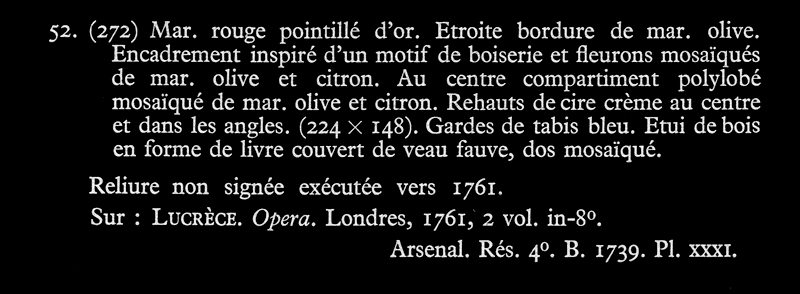
| The black and white binding shown above has been reproduced from Louis-Marie Michon's 1956 Pl. XXXI. Immediately below it, I include Michon's information concerning this binding which he has mistakenly attributed to Derome le jeune. It could not be attributed to Jacques-Antoine Derome as he died in 1760, this binding could not have been made before the 1761 publication date of the book which it covers. This is a criticially important fact to note as well as observing that Derome did not even have his papers as a binder until 1761, to imagine that he could have made these bindings at the very start of his career most unlikely. You will see that these two bindings show some amazing similarity in design elements and imprints. If we have proved on the previous page the Dubuisson produced the Gulbenkian LA250 binding as well as the Michon Pl XVIII binding which it resemblers closely then whe have to conclude that Dubuissson also made these binding and that all of the bindings were quite likely to have been made around the year 1761. If this turns out to be true, these may have been some of the last bindings Dubuisson ever made. He died in 1762 at the age of 54, we do not know his cause of death, its is possible that he was not able to do these bindings in the last years of his life but all the indications appear to suggest that he did. The BnF information for the binding RES-H-2014 states that it was made around 1760 in an unidentified workshop |

| In Comparative Diagram 2 we can see just how similar these bindings are. I think it very likely that they were all made around the same period, that is to say from 1760 to 1762. Now I want to present a binding that might have been made not long after the death of Pierre-Paul Dubuisson. This binding is found in a 2015 Christies Catalogue that you can see online here (lot #56). I have reproduced it below with the accompanying text. The Christies experts mention that Michon attributed this binding to Derome le jeune, but also say that it is probably a Dubuisson. This is amazing, for once the experts have questioned Michon's attributions. Now the odd part of all this is that it is quite possible that Dubuisson was no longer alive when this binding was made. Consider too that this binding was destined for a client of the highest level, The portrait in the center of the binding is of Madame de Pompadour (check this amazing site of every portrait ever made of her) |
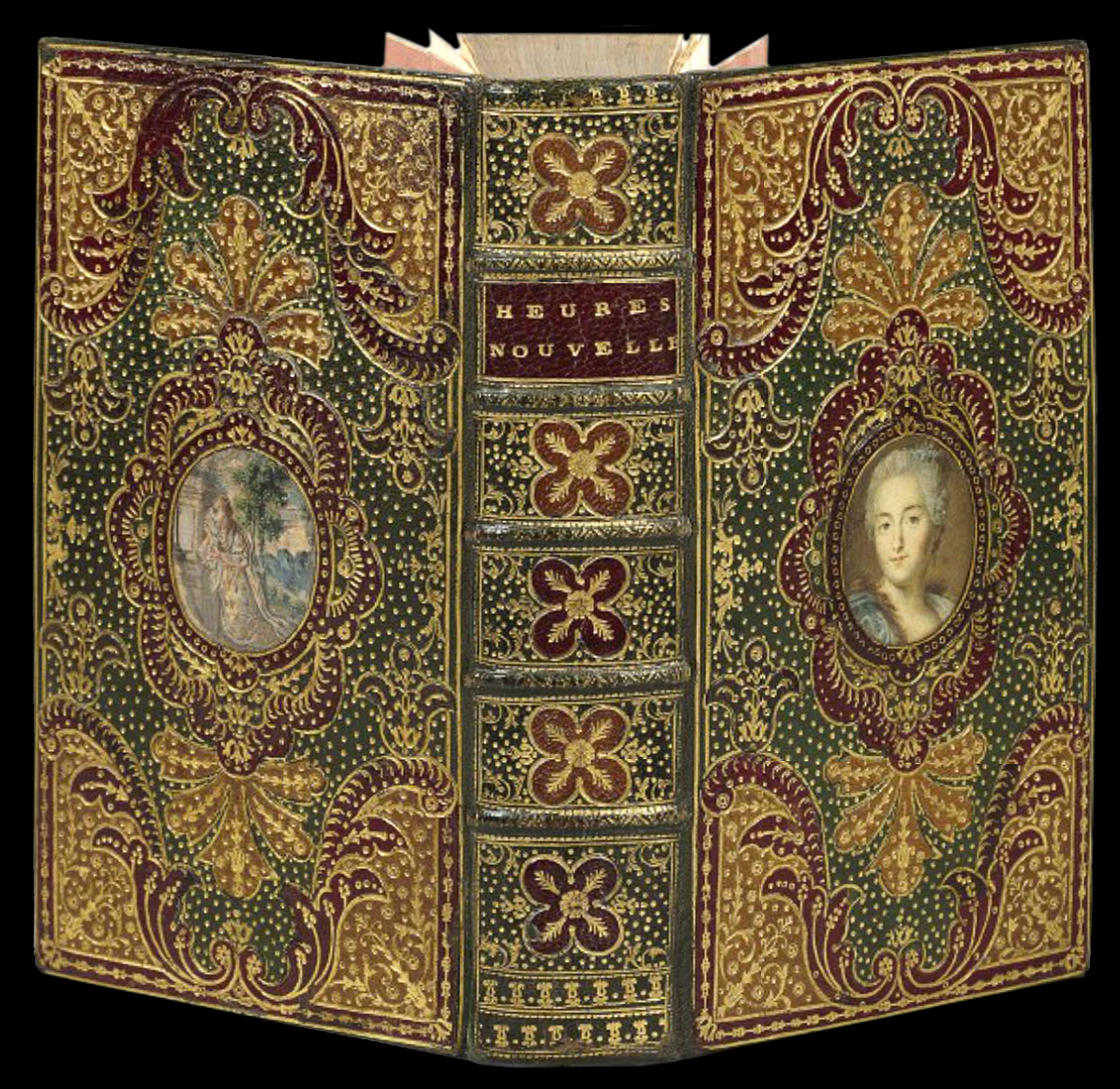
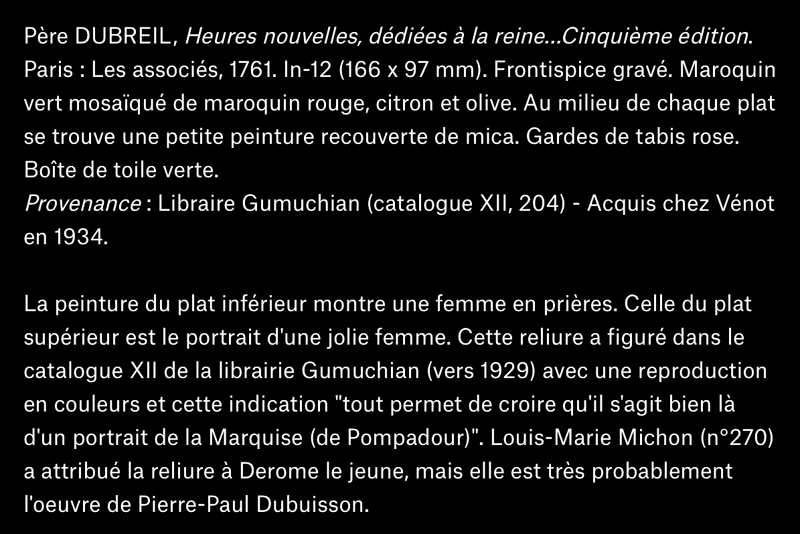
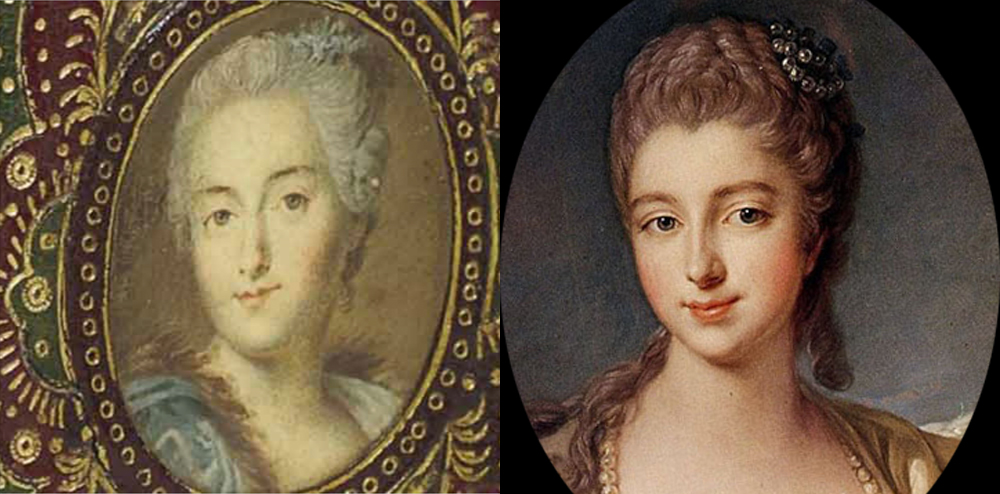
| I want to remind the reader that we are exploring this work together, I am not the all knowing expert, here we are discovering things together. I found this binding in a Christies catalogue only recently and now that we have been researching the Etat bindings. I see here in this binding distinct Etat tools, tools that Dubuisson may have never owned, and mixed with these are what appear to be Dubuisson's tools or rather the imprints that derive from them. Unfortunately the Christies enlargements are not crystal clear, however they are good enough to to allow us to make some interesting observations. Imagine that this binding has been made by someone, possibly an apprentice who has worked with Dubuisson long enough to master the not only the job of gold tooling, but also the design arrangements practised by the master. Such an analysis falls short because the apprentice appears to be introducing quite rapidly new tools. This to me suggests that the person who took over where Dubuisson left off, was not an apprentice but was rather a skilled doreur who worked with him, someone who probably had some tools of his own, these are the tools that we find on the Etat bindings. We will always want to know who did what, which bindings were the last that Dubuisson made, for me the appearance of the Etat tools signals this separation that could have even appeared before Dubuisson's passing. This Christies binding could have been made in 1761 however it might have been made a few years later as certain indicators might suggest. |
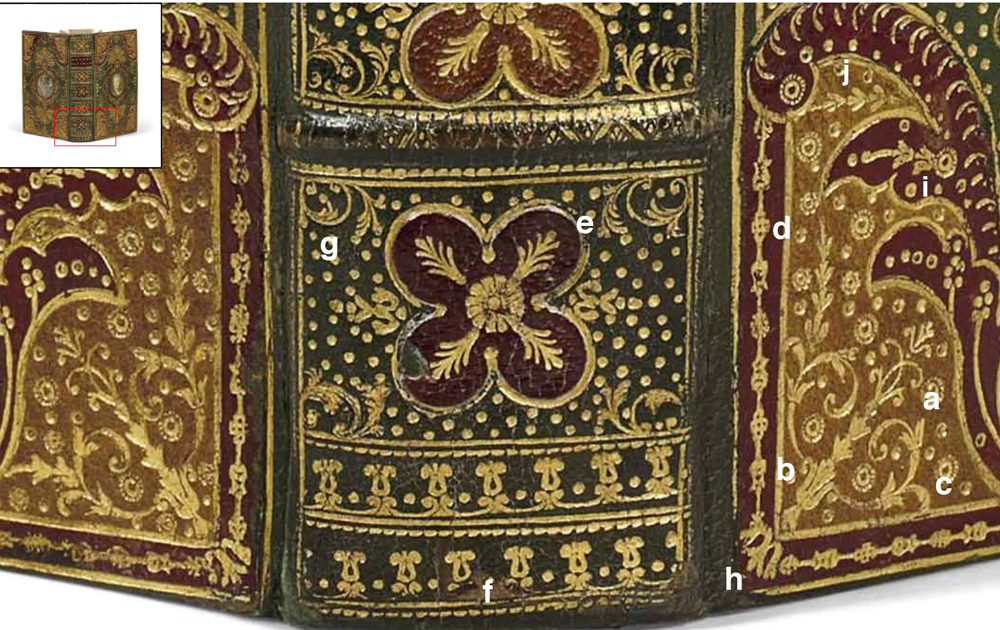
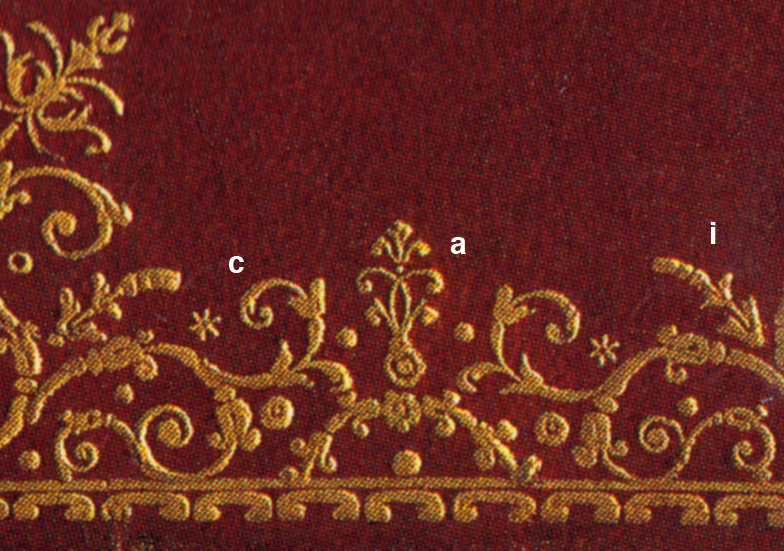
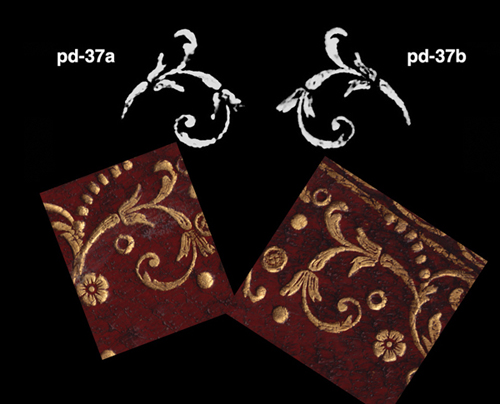
| In the images above we see firstly an enlarged detail of the imprints found on the Christies binding, the imprints shown at 'a' and 'b' I do not remember seeing in the works of Dubuisson, however the imprint at 'a' is a distinct Etat tool as can be seen in the diagram below the Christies detail. I have previously tried to compare the pd-37 imprints with those of found on the Etat bindings, this is a small imprint that I do not have a really good type model of, and the difference seen here might be due only to the fact that the Dubuisson imprints are poorly represented in this diagram. They are anyway, a very close match, and as we have found other Dubuisson imprints in the Etat collection I suspect that these again derive from Dubuissons original tools. The roulette like border that probably has not been made with a roulette shown at 'd' appears to be the same as the one found on Pl. XXXI and both bindings use a trident tool (see 'h') in the corners in a identical way but probably with a different trident. The spine panels of the Christies binding appear to be of an inferior quality nowhere near as refined as the examples shown in Comparative Diagram 2. Also we see a palette at the bottom of the spine that has not been used in the other bindings thought to be from the 1760 period. The common Dubuisson palette of this type has an alternating pattern, this example then appears to be only an approximate copy of the original. In general, this Christies binding looks quite similar to some of the other Mosaics, however the level of workmanship is not comparable to the Gulbenkian LA250 which is much more elaborate and detailed, and better made. The doreur who has decorated this binding is therefore not likely to be the same one who has decorated the bindings shown on the previous page, this then I think is the early work of the Etat binder working in the Dubuisson workshop as a replacement binder. This conclusion seems reasonable in as much this binding has fooled the Christies experts as well as Michon. The imprint shown below in Comparative Diagram 4 is part of the reason behind this confusion, this is obviously a Dubuisson imprint, proof that this binding derives from the Dubuisson workshops. The asymmetric differences in pd-3 make it's identification an easy matter, even if it has been distorted by a number of possible causes. |
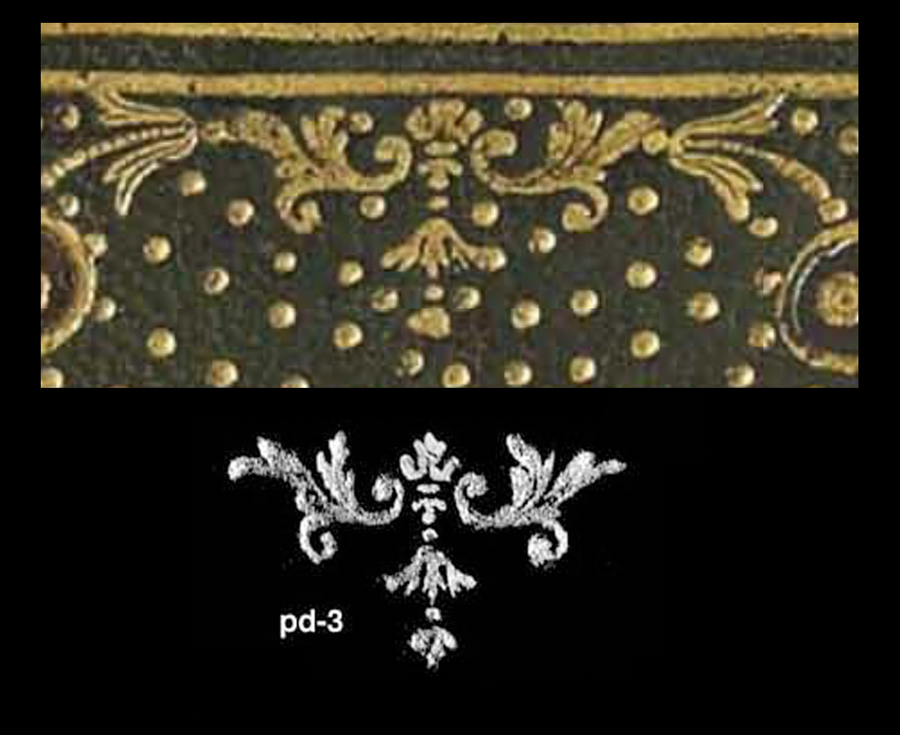
|
click here see the NEXT page. click here to go to the INDEX of new pages. click here to return to the Virtual Bookbindings HOME page. see below links to previous work |
| Even experts are sometimes wrong, before you spend thousands on a book, please do your own research! Just because I say a certain binding can be attributed to le Maitre isn't any kind of guarantee, don't take my word for it, go a step further and get your own proof. In these pages I have provided you with a way of doing just that. |
| Virtual Bookings, created by L. A. Miller | return to the Home page of VIRTUAL BOOKBINDINGS |